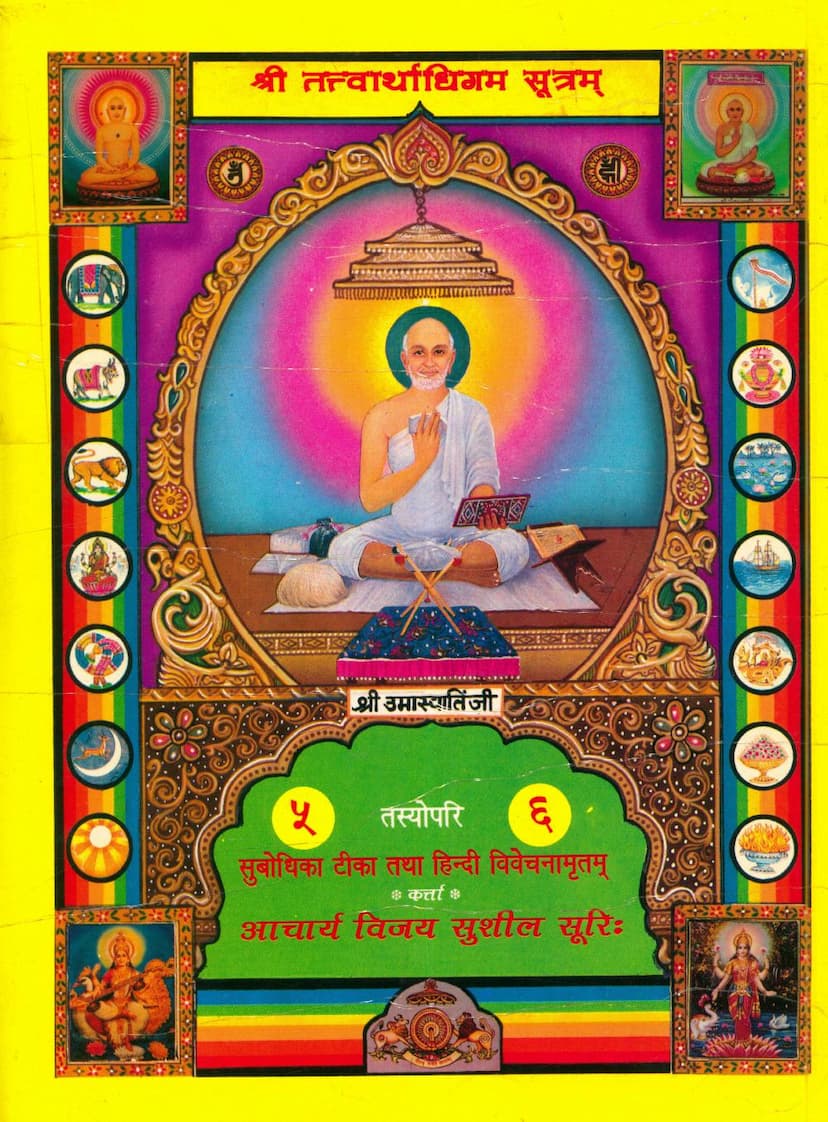Tattvarthadhigam Sutraam Tasyopari Subodhika Tika Tatha Hindi Vivechanamrut Part 05 06
Added to library: September 2, 2025

Summary
This Jain text, titled "Tattvarthadhigam Sutraam Tasyopari Subodhika Tika Tatha Hindi Vivechanamrut Part 05 06," authored by Vijaysushilsuri and published by Sushil Sahitya Prakashan Samiti, is a commentary and explanation of the Tattvartha Sutra, specifically focusing on its fifth and sixth chapters. The book is dedicated to the teachings and life of esteemed Jain Acharyas and the foundational principles of Jainism.
Core Content:
The text is primarily a detailed exposition of chapters five and six of the Tattvartha Sutra, a foundational scripture in Jainism. The original Tattvartha Sutra was composed by the revered Acharya Umaswati. This particular publication provides a Sanskrit commentary (Tika) called 'Subodhika' and a Hindi explanation called 'Vivechanamrut,' both authored by Acharya Vijay Sushil Suri.
Key Themes and Topics Covered (based on chapter summaries and headings):
- The Nature of Reality (Tattvas): The Tattvartha Sutra is renowned for its systematic classification of reality into seven categories (tattvas) – Jiva (soul), Ajiva (non-soul), Asrava (influx), Bandha (bondage), Samvara (stoppage of influx), Nirjara (shedding of karma), and Moksha (liberation). Chapters five and six delve into specific aspects of these tattvas.
- Chapter V (Ajiva Tattva): This chapter focuses on the Ajiva (non-soul) category. It elaborates on the five types of Ajiva substances:
- Dharmastikaya: The medium of motion.
- Adharmastikaya: The medium of rest.
- Akashastikaya: Space.
- Kalastikaya: Time.
- Pudgalastikaya: Matter. The commentary likely explains their characteristics, properties (like formlessness or form), count (e.g., only one Dharmastikaya, Adharmastikaya, Akashastikaya, but many Pudgalas), their role in the universe, and their numerical and spatial attributes (like the number of regions or 'pradeshas' they occupy). It also discusses the nature of Pudgala, its various forms, and the qualities it possesses (like touch, taste, smell, and color).
- Chapter VI (Asrava Tattva): This chapter deals with Asrava, the influx of karma into the soul. It explains:
- Yoga: The activities of the body (kaya), speech (vach), and mind (manas) which are the primary causes of Asrava. The text likely details the different types of Yoga (physical, verbal, mental) and their classification into auspicious (punya-causing) and inauspicious (papa-causing) activities.
- Kashaya: The passions (anger, pride, delusion, greed) are identified as the root cause of karma bondage and are elaborated upon.
- Karma: The text discusses how different intentions and actions (yogic activities driven by passions or without them) lead to the influx of specific types of karmas, such as those that bind to the cycle of birth and death (Punya and Papa), those that determine the state of existence (like Naraka, Tiryancha, Manushya, Deva ayushyas), those that affect physical characteristics (like Pudgala), and those that influence one's disposition and destiny (like Naam karma, Sandarshan Mohaniya, Charitra Mohaniya, Antaraya karma).
- Causes of Bondage: The commentary details specific actions, thoughts, and passions that lead to the influx and bondage of different karmas, including the causes for higher and lower birth, vices, and virtues.
- Tirthankara Nama Karma: The text highlights the specific actions and pure intentions that lead to the bondage of Tirthankara Nama Karma, which results in the soul becoming a spiritual guide for humanity.
- Upadhis (Means/Facilitators): The role of external and internal means in karma bondage is discussed, classifying them as Jiva-adhikarana (related to the soul's passions and activities) and Ajiva-adhikarana (related to external objects and tools).
- Distinction between Punya and Papa: The text likely distinguishes between meritorious (punya) and demeritorious (papa) actions and their karmic consequences.
Author and Commentary:
- Acharya Umaswati: The original author of the Tattvartha Sutra, considered a seminal work that bridges the philosophical divide between the Shvetambara and Digambara traditions of Jainism.
- Acharya Vijay Sushil Suri: The author of the commentary and Hindi explanation. The provided text highlights his prolific writing (over 125 books), his dedication to spreading Jain principles through extensive travel, and his scholarly acumen. The commentary aims to make the profound teachings of the Tattvartha Sutra accessible to a wider audience through simple Sanskrit and clear Hindi.
Context and Significance:
The Tattvartha Sutra is often called the "Science of Reality" and is considered authoritative by both major Jain sects. This specific publication, with its detailed commentary and Hindi explanation, serves to make this complex philosophical text understandable and applicable to spiritual aspirants. The emphasis on the author's life and lineage, along with the mention of various patrons and collaborators, underscores the traditional method of transmitting and preserving important religious and philosophical knowledge. The work is presented with great reverence, indicated by the extensive praise and dedications to the lineage of Acharyas.
In essence, this volume is a scholarly and devotional work aimed at explaining the intricate details of Jain philosophy concerning the nature of non-soul substances (Ajiva) and the processes of karma influx (Asrava), providing guidance for spiritual progress and liberation.